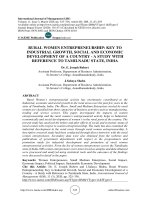Economic growth and economic development 177
Bạn đang xem bản rút gọn của tài liệu. Xem và tải ngay bản đầy đủ của tài liệu tại đây (59.88 KB, 1 trang )
Introduction to Modern Economic Growth
past 2000 years, thus it is unlikely that simple economies of scale to population
are responsible for the economic takeoff in Western Europe while Asia stagnated.
We will return to an explanation for why economic growth might have taken off in
Western Europe in Chapter 27.
We conclude from this discussion that models based on economies of scale of
one sort or another do not provide us with fundamental causes of cross-country
income differences. At best, they are theories of world growth (the world taken as a
whole). Moreover, once we recognize that the modern economic growth process was
uneven, meaning that it took place in some parts of the world and not others, the
appeal of such theories diminishes further. If economies of scale were responsible
for modern economic growth, it should also be able to explain when and where
this process of economic growth started. Existing models based on economies of
scale do not. In this sense, they are unlikely to provide the fundamental causes of
modern economic growth. Does this mean that these types of economies of scale and
increasing returns to population are unimportant? Certainly not. They may well
be part of the proximate causes of the growth process (for example, the part lying
in the black box of technology). But this discussion suggests that these models need
to be augmented by fundamental causes in order to explain why, when and where
the takeoff occurred. This further motivates our investigation of the fundamental
causes.
4.3. The Four Fundamental Causes
4.3.1. Luck and Multiple Equilibria. In Chapter 22, we will see a number
of models in which multiple equilibria or multiple steady states can arise because
of coordination failures in the product market or because of imperfections in credit
markets. These models suggest that an economy, with given parameter values,
can exhibit very different types of behavior, some with higher levels of income or
perhaps sustained growth, while others correspond to poverty and stagnation. To
163









